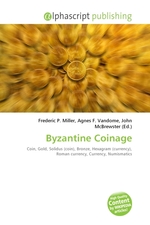Byzantine Coinage
Frederic P. Miller, Agnes F. Vandome, John McBrewster
бумажная книга
Byzantine currency, money used in the Eastern Roman Empire after the fall of the West, consisted of mainly two types of coins: the gold solidus and a variety of clearly valued bronze coins. By the end of the empire the currency was issued only in silver stavrata and minor copper coins with no gold issue. Early Byzantine coins continue the late Roman conventions: on the obverse the head of the Emperor, now full face rather than in profile, and on the reverse, usually a Christian symbol such as the cross, or a Victory or an angel (the two tending to merge into one another). The gold coins of Justinian II departed from these stable conventions by putting a bust of Christ on the obverse, and a half or full-length portrait of the Emperor on the reverse. These innovations incidentally had the effect of leading the Islamic Caliph Abd al-Malik, who had previously copied Byzantine styles but replacing Christian symbols with Islamic equivalents, finally to develop a distinctive Islamic style, with only lettering on both sides. This was then used on nearly all Islamic coinage until the modern period.
Данное издание не является оригинальным. Книга печатается по технологии принт-он-деманд после получения заказа.


